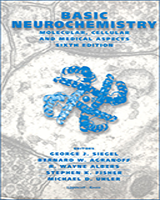By agreement with the publisher, this book is accessible by the search feature, but cannot be browsed.
NCBI Bookshelf. A service of the National Library of Medicine, National Institutes of Health.
Siegel GJ, Agranoff BW, Albers RW, et al., editors. Basic Neurochemistry: Molecular, Cellular and Medical Aspects. 6th edition. Philadelphia: Lippincott-Raven; 1999.

Basic Neurochemistry: Molecular, Cellular and Medical Aspects. 6th edition.
Show detailsThe brain contains multiple classes of receptors for catecholamines
Effects of DA are mediated through interaction with D1-like (D1 and D5) and D2-like (D2, D3 and D4) receptors (Table 12-3), while effects of NE and epinephrine are mediated through α1- and α2-adrenergic receptors (Tables 12-4, 12-5) and through β-adrenergic receptors (Table 12-6). As of the present time, three subtypes of α1-, three subtypes of α2- and three subtypes of β-adrenergic receptors have been identified (Tables 12-4–12-6). Mice lacking these receptors can have significant physiological deficits (Table 12-1). The postsynaptic receptors on any given neuron receive information from transmitters released by another neuron. Typically, postsynaptic receptors are located on dendrites or cell bodies of neurons, but they may also occur on axons or nerve terminals; in the latter case, an axoaxonic synaptic relationship may cause presynaptic inhibition or excitation. In contrast, autoreceptors are situated on a given neuron and respond to transmitter molecules released from the same neuron. Autoreceptors may be widely distributed on the surface of the neuron. At the nerve terminal, they respond to transmitter molecules released into the synaptic cleft; on the cell body, they may respond to transmitter molecules released by dendrites. Functionally, most autoreceptors appear to regulate transmitter release in such a way that the released transmitter, acting on autoreceptors, regulates additional release. Autoreceptors have been identified for NE-, DA-, serotonin- and GABA-containing neurons. A major type of inhibitory autoreceptor described in both the sympathetic PNS and the brain has pharmacological properties resembling those of the α2-adrenergic receptor [20].
Table 12-3
Properties of Cloned Dopamine Receptor Subtypes.
Table 12-4
Subtypes of α1-Adrenergic Receptor.
Table 12-5
Subtypes of α2-Adrenergic Receptor.
Table 12-6
Subtypes of β-Adrenergic Receptor.
In the sympathetic PNS, autoreceptors of the β-adrenergic type have also been described. These differ from most other known autoreceptors in that NE acting on these receptors facilitates transmitter release and thus amplifies the effects of neuronal firing. This effect contrasts with the inhibitory action of α-adrenergic and DA autoreceptors, which exert negative feedback control on transmitter release. The DA autoreceptors in the nigrostriatal pathway appear to be of the D2 subtype.
- Catecholamine Receptors - Basic NeurochemistryCatecholamine Receptors - Basic Neurochemistry
Your browsing activity is empty.
Activity recording is turned off.
See more...